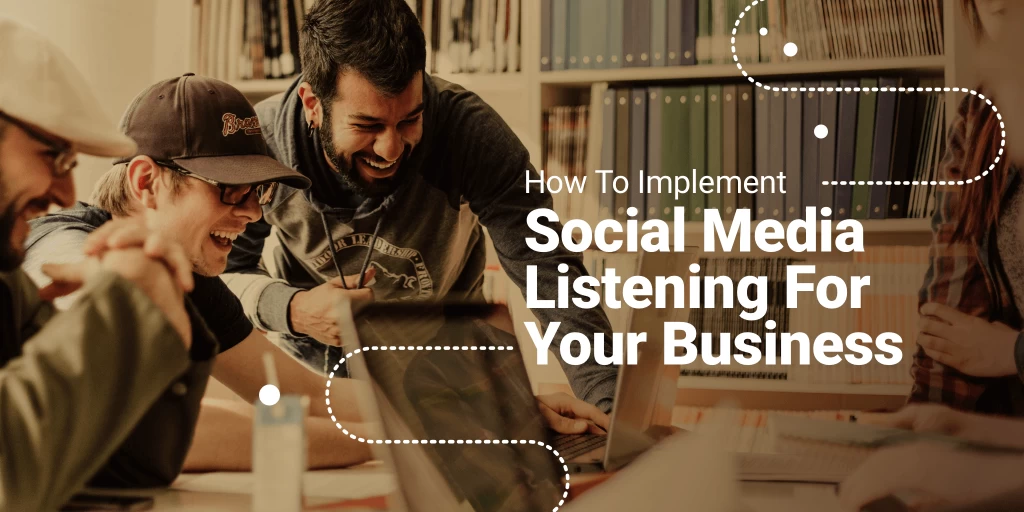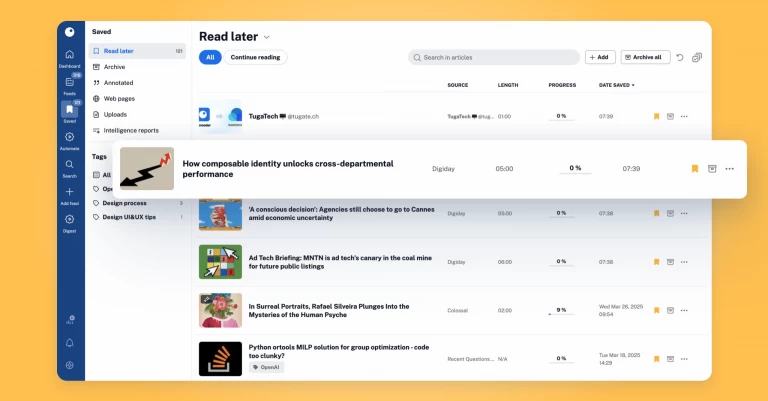How To Implement Social Media Listening For Your Business

Today’s buzzword is ‘social media listening’ – everyone seems to be talking about and they are. All for a good reason. You can’t have a successful marketing strategy without paying attention to social media.
It’s a free resource. All you have to do is pay close attention to online conversations and draw your conclusions. As brands exist more and more as digital entities with social media presence, there’s no other way to connect with your audience and sell products.
If you’re not practicing social media listening, here’s the rundown.
What is social media listening?
Social media listening is a data-driven analytical process based on the surveillance of social media platforms to identify market opportunities, prospect buyers and successful marketing strategies to increase sales leads and promote a brand to a wider audience.
It begins with monitoring your social media accounts with an emphasis on customer interaction (social media monitoring is often confused with listening, though they are different) and expands to monitoring important online spaces your audience inhabits. With the right listening tool, brands are equipped to not only see the bigger picture, but also derive actionable insights on how to better perform in their market.
On the ground level, brands understand why certain content and campaigns work with customers and improve public sentiment through sensible customer service. On a strategic level, brands have a deeper understanding of their audience and the bigger trends shaping their sector.
Why does social media listening matter?
Sleek packaging, affordable price points and even a good product don’t really matter all that much to customers compared to the value they receive from a brand’s service. It’s all relative, of course, – it’s a prerequisite to even grow a customer base without any of these elements. But consumers are much more vocal about the service and treatment they receive from brands.
We’ve all been burned by a company, which promises the stars and the moon, but ghosts you after the transaction is completed. That’s all it takes to lose them as repeat customers – a business model without much potential for longevity. To add salt to the wound, dissatisfied customers are not shy about sharing their tales of woe. It takes a well-written post on Facebook or Twitter to reach much more than their intended small social bubble.
Social media listening nips such issues in the bud by improving customer care, resulting in happy return customers willing to spend a lot more on a brand’s catalog. It’s a no-brainer, really, because social media listening reduces operational costs. Millennials famously avoid phone conversations so hiring social media operators reduces costs associated with running phone support. It’s faster, cheaper and delivers results instantaneously.
What’s best – not as many companies are doing social media listening with emphasis on stronger customer service. Instantly you stand out in your field.
Social media listening basic strategies
Social media listening gives itself over to complete customization so you can develop a strategy based entirely on a brand’s current position in a market or situation a brand finds itself in whether it’s a scandal or a viral rise to fame. It’s this versatility, which makes it the perfect tool for the new millennium.
At its heart, one finds several basic starting points, which point marketers in the right direction in the early adoption stages of social media listening. These basic strategies find themselves further discussed in details in the points below, but let’s list them out:
- Brand health – a brand’s standing in the court of public opinion and its popularity
- Industry insights – state of the overall industry and a brand’s place in it
- Competitive analysis – insights into a brand’s rival within their sector
- Campaign analysis – the investigation of campaign performance
- Event analysis – similar to the one above, it’s analyzing audience reaction to a specific event from a conference to exhibitions and trade shows
How to use social media listening for business?
Each social media listening strategy has a similar trajectory whatever the end goal is.
Marketers select the online platforms and spaces they want to monitor alongside the right tool for the job based on features and price points – the price spectrum varies wildly for such services.
Next is deciding on the keywords and other metrics to closely monitor complete with notifications where necessary for real-time intervention (has most to do with handling in-the-moment customer interactions through tagged posts and direct comments). It’s important to note the starting and end point to the listening and then generate reports on engagement, audience analysis and more.
Your goals drive the process forward and you might want to…
Track and measure campaigns
Campaigns are best suited to generate the most valuable insights as they have a definite beginning and a definite end. Ideally, you should also have specific goals in mind for the campaign (I have seen many that seem purposeless) and apply social media listening to establish performance norms. In essence, every campaign you run becomes a contained experiment.
So pay attention. To be extra smart, pick social media campaigns run by other brands. Who is your biggest rival that always lands a step ahead? Who is the brand you want to emulate most because you connect with their essence and messaging? Put their campaigns under the magnifying lens.
All social listening tools generate reports breaking down performance based on social stats for the content share, activity on the branded hashtag and influx of new followers. These benchmarks are then useful in planning your next campaign as goals to beat. Further analysis of your audience has its own benefits – knowing more about which customers you want to target specifically.
Boost your sales efforts
Through carefully monitoring specific non-branded keywords and phrases, you can detect Internet users who match your buyer persona, but haven’t heard about your brand… yet. This might be a person who is ready to buy and asks for recommendations, or a disgruntled customer of a competitor who is not receiving quality customer care. Or even a person discussing a relevant industry trend.
Either way social media listening pinpoints prospect buyers, who are far along the sales funnel. All they need is a little push – a pleasant interaction with your social media team. Emphasize on the value you bring to the person’s life rather than lay heavy on the sales pitch. There will be times when you can confidently say, ‘just buy our product,’ and even so the right approach is always to solve a problem.
Explain how you’re able to fix their problem. Point them towards the product or service suited best to their criteria. Step in to explain to a displeased customer of a competitor how you can be of their service. Supply them with valuable information about their industry query.
Research your industry and competition
Whoever proclaimed ‘great artists steal’ was onto something. Competition can be the biggest and most reliable sources of inspiration. Pay attention to competitors – both on top of the food chain and up-and-comers – who achieve high rates of social engagement and receive positive reception.
No brand exists within a vacuum and it’s smart to identify successful ideas and then apply them to your branding. Competition teaches us how to be successful through their highs and through their mistakes. Social media listening reveals all nuance in the social sentiment towards a brand and you should use it to its full potential.
Research should also expand towards the entire industry. What is the breaking news that prompts a timely reply to keep you within the public’s eye? In recent years, companies have stepped out of their areas of expertise and comment on political news all the time. Just look at Ben & Jerry’s. On a more practical note, industry analysis points out seasons with higher demands and geographic locations with most sales.
Get to know your customers better
Social media listening acquaints you with your audience much better. The right tool and strategy reveals where your audience congregates on the Internet – on platforms you haven’t penetrated yet whether that’s because you didn’t consider them important or didn’t even know.
Seize the chance to mine these spaces for data points. One way is to create accounts and engage directly with your target audience, or stay hidden in the background. You should not underestimate the power and popularity of forums, groups and online communities. You’re likely to understand a lot about their values, needs and concerns – both on an industry level, and on a brand level be it towards you or your competitors.
Another benefit is better identifying the buyer personas of your customer base. Every brand has a strong conviction about who their customer is. The reality doesn’t 100% align with these personas. You might be surprised at what other demographic uses your products, which opens new market pockets for you to explore through a new marketing push.
The best tools for social media listening
Let’s head with the most affordable option. With a little creativity, you can transform RSS into a tool for social media listening. By combining natural support for Google Alerts and great discovery features, you can turn your RSS reader into a listening tool (one of the many things RSS can be used for) fit for small jobs such as monitoring and later analyzing data surrounding branded campaigns.
The right RSS reader makes all the difference. Inoreader is more than up to the task as it’s proven itself to have the best native search in the business as well as seamless support for social media feeds and superior filtering capabilities.
Professional tools created for this specific job include Sprout Social, which is one of the most often mentioned tools for social media listening. It’s perfect to manage all your social media feeds and receive timely reports on both keywords and trends within your industry. At the right price point, users also unlock advanced techniques that enrich your overall experience.
Keyhole is another top contender given its strong analytical features for data regarding hashtags, URLs, keywords and usernames on Twitter and Instagram. Users can discover a lot from expected data surrounding top posts based on their performance to who are the users generating the most reach with your tracked terms. This last feature is highly useful, when you’re trying to identify the biggest influencers in your field.
We leave Talkwalker last, because it’s one of the priciest tools on the market and it’s worth every single dollar. In addition to data from numerous social media platforms, users can also source data from blogs, forums and online news websites. You can get any deeper insight than this!


